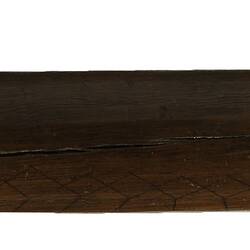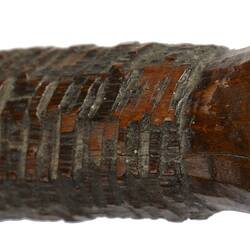Summary
Digging sticks formed an integral part of a woman's tool kit. Women used them to harvest food, especially roots, tubers, bush onions and bulrush stems, but also small animals such as frogs, reptiles, kangaroo mice, bandicoots and echidna. Following the release of rabbits into South Australia in 1866 these were also hunted by men and women using digging sticks to dig them out of their burrows.
Digging sticks were regarded as a woman's own personal property, and would not normally be borrowed or used by another woman. But her husband, when they were hunting together, would often use the digging stick to dig out a small marsupial or as a probe to test the ground in search of larger lizards. Women took great care of these important tools and a well-balanced one was highly valued and frequently repaired to prolong its use.
Digging sticks were carefully fashioned from a hardwood, such as Mulga, when the wood was green. It was shaped and then hardened by charring or through applying animal fat, which also waterproofed the digging stick. The katha's end was then ground with stone tools or rubbed on whetstones to form either a chisel-shaped or a pointed end. The incised lines at the top provided the user with a grip, reducing slippage and allowing the digging stick to be used with greater force.
Physical Description
Digging stick with circular cross section. The handle, between the shaft and a small bulbous tip, has been roughened. The distal end has been carved into a sort of wedge with a convex section. Part of the surface of the shaft has been incised with mainly zig-zag patterns and also pictured are a number of objects which resemble clubs and a human figure.
Significance
This katha (digging stick) is from the Kaurna peoples of the Adelaide Plains, South Australia, whose lands extend from Cape Jervis at the bottom of the Fleurieu Peninsula to Port Wakefield in the east and as far north as Crystal Brook. In recent times there has been a revival of Kaurna language and the Kaurna people's culture and history are at the fore in Adelaide through major public artworks in prominent locations which incorporate Kaurna language and themes. The Adelaide City Council has worked with prominent Kaurna Elders to enact a place-naming initiative which has seen all the city parks, squares and the river which runs through the city reinscribed with Kaurna names.
More Information
-
Object/Medium
Digging implement
-
Maker
-
Locality
-
Date Produced
-
Collector
-
Date Collected
-
Object Measurements
845 mm (Length), 40 mm (Width), 35 mm (Height)
-
Classification
-
Date Made
-
Maker
-
Clan/Language Group
-
Place Made
-
Indigenous Region
-
Collection Names
-
Type of item
-
Discipline
-
Category
-
Collecting Areas






